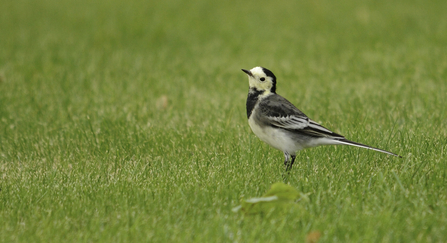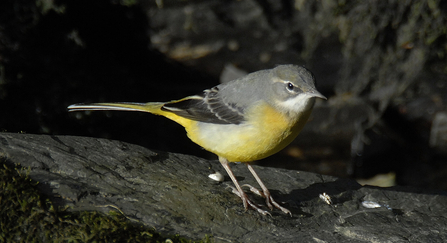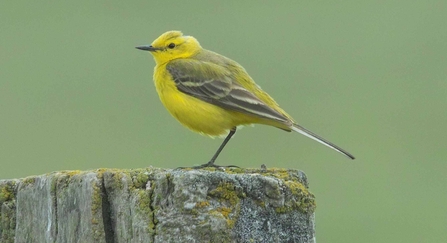Pied wagtails are resident throughout the UK, and easily recognised. These smart, active little birds with their dapper black and white plumage can be seen running around car parks, playing fields and just about any open, flat area, frantically wagging their tails up and down and leaping into the air to catch insects.
Wagtails
Pied wagtail (Motacilla alba yarrellii) (c) Chris Gomersall/2020VISION

Pied wagtail (c) Amy Lewis
Large roosts form in winter, in reed beds but also in urban areas – look out for them on supermarket roofs, electric sub-stations, telephone exchanges or anywhere else a bit of warmth is generated. They’ve even been seen cwtched up in a municipal Christmas tree after the lights had been switched on! ‘Our’ pied wagtail is a sub-species of the European white wagtail, which sometimes appears here as a passage migrant, and can be recognised by its having grey rather than black upper parts.
Much less common is our other resident wagtail, the grey wagtail. This is the most ‘extreme’ wagtail, with shorter legs and a longer tail than the others, and it wags its tail so enthusiastically, its whole rear end wags with it. Much more closely associated with water, they breed by fast-flowing upland streams with rocky wooded edges.

Grey wagtail - Steve Waterhouse
In the winter, though, they can be found by lakes and rivers throughout the county, and may even appear in gardens. Some confusion is caused by the male grey wagtail having a bright yellow underside, leading people to think they’ve seen a ‘yellow’ wagtail – look under its chin, and you’ll see adult grey wags have a black (male) or grey (female) bib.
The real yellow wagtail has a distinctly shorter tail than the grey. It’s a very variable species, with no fewer than eleven European races illustrated in Collins Bird Guide. Those breeding in Britain have yellow faces, as well as yellow undersides. They usually nest in lowland wet meadows and marshes but will also resort to arable fields.

Yellow wagtail (c) Derek Moore
Yellow wagtails are migrants, wintering in west Africa, and birds of other races, such as blue-headed wagtails, may be seen on passage. Like many of our insectivorous migrant birds, numbers are declining. Birds of Shropshire (2019) estimates 200 pairs in the county compared with 400-600 pairs in 2004 and 1151-2300 in the 1992 Atlas, putting them on the UK red list of birds of conservation concern.
Whichever wagtails you’re watching, they’re bound to bring joy with their lively behaviour and stunning good looks. Get out to your nearest lake or river and see if you can spot them!

